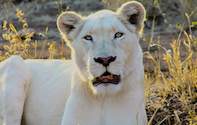
The controversy around the re-introduction of white lions in the Klaserie area was once again evidenced by a lively debate following a presentation by Linda Tucker and others of the Global White Lion Protection Trust (GWLPT). The Lowveld branch of the Wildlife and Environmental Society (Wessa) facilitated the event at the Barnyard in White River on June 17.
Cultural and Spiritual Role
With African drums shaping the atmosphere, Tucker focused on the cultural and spiritual role of the white lion, reiterating the gist of the GWLPT website. It states that "to the African elders, used to looking for spiritual signs in the nature, the White Lion's arrival was the fulfilment of ancient prophecy that identified these majestic creatures as angelic messengers from God. ... the African elders explained the mysterious white colour in spiritual terms, meaning purity and enlightenment, beyond all racial connotations."
It goes on to say, "Tragically, all white lions today are in captivity. After their forced removals from their sacred homelands, they have been extinct in the wild for over 12 years." In many of her previous presentations Linda has made a strong case for the re-introduction of the white lions to the Timbavati, claiming it as 'a sacred site as identified by African Kings for many hundreds of years.' The Kruger National Park has previously expressed concern about the conservation value of the project.
Dr Gus Mills, carnivore conservation specialist at Kruger, said the lioness and her cubs are almost certainly inbred as they have been selectively bred in captivity for a number of years. "The introduction of inbred animals into the system can only have detrimental effects." Even if the lions to be introduced were not inbred, white lions did not only occur in the Timbavati area. A white lion male was regularly seen between Tshokwane and Lower Sabie as recently as 1992.
"White lions will in all probability reappear in the system in time." At the Wessa presentation about the 125 people present were about equally divided about the GWLTP white lion project or aspects thereof. Jeremy Anderson questioned Linda's claim that killing a lion in the African culture is a 'terrible thing.' He contrasted the Masai practice for a young man to kill a lion to prove his manhood.
He also questioned a statement by Jason Turner, lion-ecologist for the project, who said that the white lion invented the art of killing in a riverbed, because of its colouring. "Does this mean no tawny lions ever hunt in the riverbed." He believes the project will enable Linda and her team to afford a preferred lifestyle.
Raising Funds
On her website (in March), Linda appeals for support. "Our scientific advisers have estimated a daily cost of approximately R350 per lion per day. Please assist to protect this country's precious white lions by sponsoring a day of their freedom. One day of freedom asks R350, two days R700, a week R2 450 and an month of freedom asks R10 500 of benefactors."
Mike Kay, a previous landowner in the Timbavati, was not at the Wessa presentation, but says Linda should be applauded and commended for her efforts to re-introduce the white lion into the wild.
Having lived on Argyle in the Timabavati for 16 years he saw the white lion that roamed there. He says if people want to give money to support Tucker, the choice is theirs. When about the probability of success he said, "What does it matter? If people want to support her financially, why not," he said. According to him the GWLPT project is similar to the Hoedspruit Cheetah project and Moholoholo Rehabilitation centre where animals are rehabilitated and released in the wild.
Linda imported the lions to the area in March on an import permit but had no holding permit as this was subject to certain conditions laid down by the Limpopo Department of Economic Development and Tourism. This included an acceptable management plan to reintroduce the animals in the wild.
Jaon previously alluded to the Department not informing the GWLTP of the need for an Environmental Impact Assessment (EIA), but agreed that as from 25 June 2005, an EIA has to be in place in terms of the DEAT draft rules and regulations on sustainable use of large predators.
Numerous attempts to get information about the current state of affairs from the Government have gone unanswered. It appears there is no holding permits and no EIA. The same questions were posed to Jason of the GWLPT. "GWLPT declines to comment because we do not want to prejudice the process.
The GWLPT has made an application to the Dept. of Finance and Economic Development for a temporary housing permit, and we are awaiting their approval. Scientific experts have been, and continue to be, consulted at every step of the project," he said.
Read more about White Lions of Timbavati

